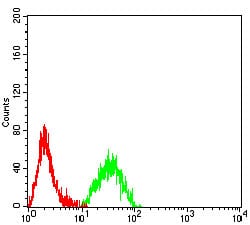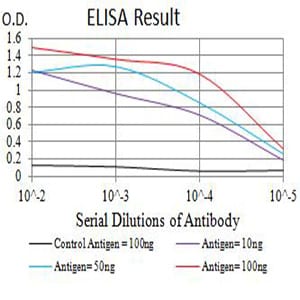

| WB | 咨询技术 | Human,Mouse,Rat |
| IF | 咨询技术 | Human,Mouse,Rat |
| IHC | 咨询技术 | Human,Mouse,Rat |
| ICC | 技术咨询 | Human,Mouse,Rat |
| FCM | 咨询技术 | Human,Mouse,Rat |
| Elisa | 咨询技术 | Human,Mouse,Rat |
| Aliases | ITGAX; SLEB6 |
| Entrez GeneID | 3687 |
| clone | 6G2D1 |
| WB Predicted band size | 127.8kDa |
| Host/Isotype | Mouse IgG1 |
| Antibody Type | Primary antibody |
| Storage | Store at 4°C short term. Aliquot and store at -20°C long term. Avoid freeze/thaw cycles. |
| Species Reactivity | Human |
| Immunogen | Purified recombinant fragment of human CD11C (AA: extra 102-279) expressed in E. Coli. |
| Formulation | Purified antibody in PBS with 0.05% sodium azide |
+ +
以下是关于Cyclophilin B抗体的3篇参考文献及其摘要:
1. **"Cyclophilin B regulates HIV-1 infectivity via incorporation into virions"**
- **作者**: Luban, J. et al.
- **摘要**: 该研究揭示了Cyclophilin B与HIV-1病毒颗粒的结合机制,证明其通过相互作用调节病毒复制。使用特异性抗体阻断Cyclophilin B可显著降低病毒在宿主细胞中的感染能力。
2. **"Secreted cyclophilin B promotes tumor angiogenesis through Raf-1/MAPK/ERK signaling pathway"**
- **作者**: Xu, Q. et al.
- **摘要**: 研究发现肿瘤细胞分泌的Cyclophilin B通过激活Raf-1信号通路促进血管生成。利用其抗体可抑制内皮细胞迁移和体内肿瘤生长,为癌症治疗提供潜在靶点。
3. **"Cyclophilin B in rheumatoid arthritis synovial fibroblasts: a novel mediator of inflammation"**
- **作者**: Billich, A. et al.
- **摘要**: 文章证实类风湿关节炎患者的滑膜成纤维细胞高表达Cyclophilin B,其抗体可阻断促炎因子释放,提示其在自身免疫疾病中的病理作用及治疗价值。
如需具体文献来源,建议通过PubMed或Google Scholar检索标题及作者获取全文信息。
Cyclophilin B (CypB), a member of the immunophilin family, is a peptidyl-prolyl isomerase (PPIase) that facilitates protein folding, trafficking, and conformational regulation. It binds to cyclosporine A (CsA), an immunosuppressive drug, forming complexes that inhibit calcineurin signaling in T-cells. CypB is primarily localized in the endoplasmic reticulum (ER) but can be secreted via unconventional pathways, playing roles in extracellular matrix remodeling, inflammation, and cellular stress responses.
Antibodies targeting CypB are vital tools for studying its involvement in pathological processes, including viral infections (e.g., hepatitis C, HIV), cancer progression, and autoimmune diseases. In cancer, CypB overexpression correlates with metastasis and chemoresistance, while in autoimmune disorders like systemic lupus erythematosus (SLE) or rheumatoid arthritis (RA), anti-CypB autoantibodies may serve as biomarkers. These antibodies are also used to explore CypB's interaction with viral proteins and its role in modulating immune evasion.
Structurally, CypB contains an N-terminal signal peptide and a conserved PPIase domain. Post-translational modifications, such as glycosylation, influence its function and antibody recognition. Research-grade CypB antibodies enable detection via Western blot, immunohistochemistry, and ELISA, aiding mechanistic studies and therapeutic development, including CsA-based therapies and CypB-targeted inhibitors. Understanding CypB's multifaceted roles continues to inform novel strategies in immunology and precision medicine.
×